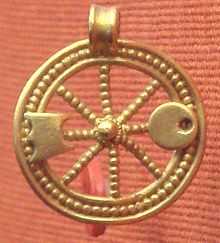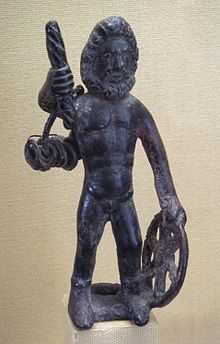Erecura

Erecura or Aerecura /ɨˈrɛkjərə/ (also found as Herecura or Eracura)[1] was a goddess worshipped in ancient times, often thought to be Celtic in origin, mostly represented with the attributes of Proserpina and associated with the Roman underworld god Dis Pater. She appears with the latter in a statue found at Oberseebach, Switzerland and in several magical texts from Austria, once in the company of Cerberus, another, probably, with Ogmios.[2] A further inscription to her has been found near Stuttgart, Germany. She may originally have been an earth goddess, associated with such attributes of fertility as the cornucopia and apple baskets; she may also have been associated with Silvanus and the Rhine Valley.. Green[3] describes Aericura as a 'Gaulish Hecuba.'
Representations of Erecura are most commonly found in the Danubian area of Southern Germany and Slovenia, but they also occur in Italy, Great Britain, and France. Her inscriptions are concentrated in Stuttgart and along the Rhine.
A male deity called Arecurius or Aericurus is named on an altar-stone in Northumberland, England.[4]
Etymology
The theonym is of unclear origin. It has been connected with Latin aes, aeris 'copper, bronze, money, wealth', era 'mistress' and the name of the Greek goddess Hera.[5] Many different Romanised forms of this goddess’s name occur: Aeraecura at Perugia; Aerecura at Mainz, Xanten, Aquileia and Roşia Montană; Aericura at Sulzbach, Malsch, Eracura in Mautern, Austria, Ercura at Fliehburg, Erecura at Cannstatt, Tongeren and Belley in Aube; Heracura at Stockstadt am Rhein, Herecura at Cannstatt, Freinsheim and Rottenburg am Neckar, where the form Herequra is also found.[6]
Epigraphic inscriptions in the Roman Empire tended to use capital letters.[7] Nonetheless, less literate members of the Roman Empire’s community sometimes misinterpreted the phonemic value of a given letter of the Latin alphabet, as apparent in the inscriptions to Belatucadrus.[8] In the Classical Latin alphabet, the capital letters A and H are not dissimilar in appearance and so may easily have been confused by less literate sections of the populace: hence, perhaps, the initial alternation between H ~ A in forms of the name. A name of the form */aireˈkura/ or */hereˈkura/ appears to underlie the alternations Aeraecura ~ Aerecura ~ Aericura ~ Eracura ~ Ercura ~ Erecura ~ Heracura ~ Herecura ~ Herequra.
Though the goddess herself may be Celtic, it is open to question whether the name is of Celtic origin or even Indo-European.
Bibliography
Works cited
- ↑ Nicole Jufer & Thierry Luginbühl. Les dieux gaulois : répertoire des noms de divinités celtiques connus par l'épigraphie, les textes antiques et la toponymie. Paris: Editions Errance, 2001. ISBN 2-87772-200-7. pp.18, 40, 45.
- ↑ Rudolf Egger. Römische Antike und frühes Christentum: Ausgewählte Schriften von Rudolf Egger; Zur Vollendung seines 80. Lebensjahres, ed. Artur Betz and Gotbert Moro. 2 vols. Klagenfurt: Verlag des Geschichtsvereines für Kärnten, 1962-63. (LOC call number DB29.E29.) I.84-85; I.276-79; II.24-33.
- ↑ Green, Miranda (2004:124). The gods of the Celts. Sparkford, UK: Sutton Publishing.
- ↑ R.G. Collingwood and R.P. Wright. The Roman Inscriptions of Britain (RIB) Vol. 1: The Inscriptions on Stone. RIB 1123. See also the relevant page of roman-britain.org.
- ↑ Egger, op. cit. I.84-85.
- ↑ Lajoye, Patrice; Inventaire des divinités celtiques de l’Antiquité, Caen: Société de Mythologie Française. Available at L’Arbre Celtique.
- ↑ Green, Miranda (2004:120–121). The gods of the Celts. Sparkford, UK: Sutton Publishing
- ↑ Green, Miranda (2004:102). The gods of the Celts. Sparkford, UK: Sutton Publishing.
Further reading
- Ellis, Peter Berresford, Dictionary of Celtic Mythology (Oxford Paperback Reference), Oxford University Press, (1994): ISBN 0-19-508961-8
- MacKillop, James. Dictionary of Celtic Mythology. Oxford: Oxford University Press, 1998. ISBN 0-19-280120-1.
- Wood, Juliette, The Celts: Life, Myth, and Art, Thorsons Publishers (2002): ISBN 0-00-764059-5

